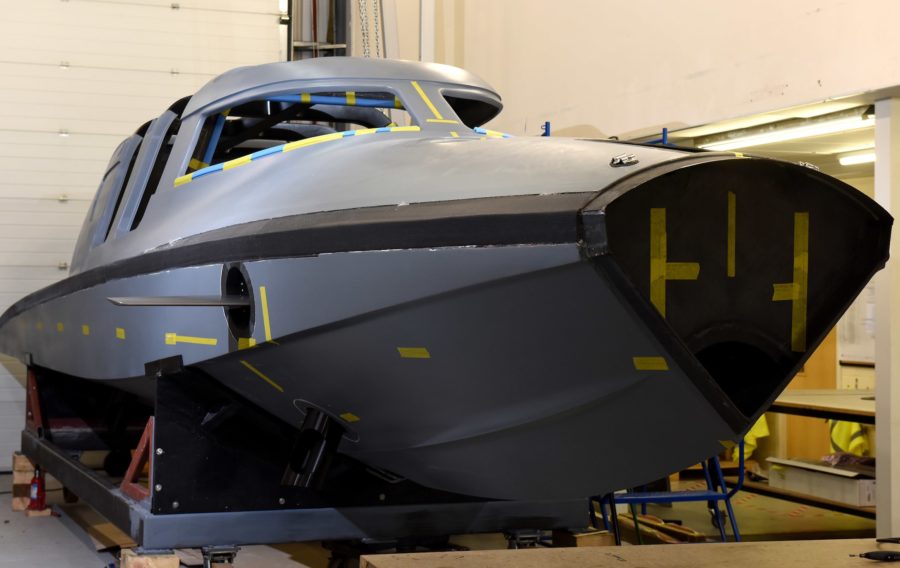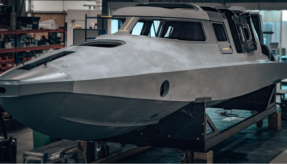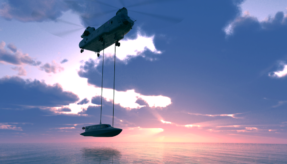
The world’s most technically advanced surface-submersible, made in Britain and set to be sold across the globe, is to hit the water in 2021.
As the build gains speed, advanced maritime technology business SubSea Craft reveals new images of the latest development of VICTA – its revolutionary craft, designed for the defence market, with special forces in mind.
The never before seen images show VICTA’s true form begin to emerge as the lower hull is bonded to the upper skin, giving shape to the whole craft for the first time this week.
Capable of operating both on AND under the water, VICTA combines the characteristics of a fast surface craft with those of a specialist submersible to deliver divers on or beneath the surface – discreetly. Using advanced design and superior, next generation technology the craft is designed around the operator and features a number of technical firsts for the maritime sector, putting it well ahead of the competition.
Its performance in both domains and the rapid transition between the two is enabled by a unique fly-by-wire control system, which delivers dynamic stability in all conditions. This ensures the craft’s safety at all times, while reducing friction in the cockpit and thus leaving the crew to focus on the mission.
Entering its final build phase, the team at Subsea Craft is working tirelessly to ensure the build quality required for VICTA’s operation at pressures up to 4BAR, while integrating the components, specially marinised, that enable its exceptional performance.
Subsea Craft has released mid-build images of this unique diver delivery unit (DDU) whose principal function is the delivery and recovery of divers with a defence-oriented mission set which could include reconnaissance, surveillance or security.
THE BUILD SO FAR
Until now, construction has been focused on the fit out of the craft, installing an array of vital components including its powerful batteries. However, this shifted dramatically in the last few days. VICTA’s true form began to emerge.
The craft is made of carbon fibre with a Diab core. A lightweight construction many times stronger than fibreglass, VICTA will be faster and more manoeuvrable than comparable craft.
A sub-marinised SeaTek 725hp diesel engine powers VICTA on the surface through a highly efficient water jet achieving speeds of up to 40 knots over a range of 250nm. Two SubCtech lithium Ion battery packs kick-in upon diving, to provide the power to enable sub-surface operation. Enclosed in fully watertight chambers, the batteries generate sufficient energy to power the submersible for up to four hours – sufficient to cover 25nm with two crew and six operators.
The design features forward and rear hydroplanes – a vital part of the control system in maintaining stability when submerged, along with vertical thrusters enhancing VICTA’s low speed manoeuvrability.
WHAT HAPPENS NEXT
As the build continues over the coming weeks, VICTA’s diesel engine will continue testing at the company’s Trials and Testing facility in Portland before installation in the craft. This precedes integration of its world-leading command & control systems as well as incorporation of the obstacle avoidance sonar that will act as VICTA’s eyes under water. This latter system is capable of building a 3D impression of the sea floor out to 600m and down to 100m, to help guide and navigate the vessel unaided.
Once complete, acrylic windows, hatches, hinges and life-support system will be installed ahead of comprehensive trials and testing.

Scott Verney, CEO, says: “Now that the dynamic shape and form of VICTA has been established, we can get to the truly exciting stages of the build. Integration of the full technical suite and control systems for the craft will be a game-changing moment. All together we have around 250 subsea connectors all controlled by the fly-by-wire on-board system – it’s the most advanced craft of its type.
“In an uncertain world, nations seek an advantage which VICTA can provide,” Verney continues. “It includes a number of technological firsts. VICTA’s engine, for example, has been fully sub-marinised in order to allow it to withstand complete immersion in salt water. We are talking about outstanding product delivery here for our clients.
“We are on track for trials and testing this coming winter, with the aim of having the craft operational late 2021.”
Funded by a private investor to the tune of £12m, the company is seeking second-stage investment to enhance working capital profiles, strengthen the brand, expand its offering and infiltrate other sectors.
Primarily aimed at the defence market, this unique British maritime technology provides significant operational capability, broadening the options for commanders of Maritime, Joint and Special operations. Although focused on defence, there is potential utility elsewhere in the leisure, research and offshore energy sectors.
The Subsea Craft team have a strong commercial, military, technology and engineering background offering unrivalled potential to generate unique products and services for their customers.
For more information and updates from the company on the progress and delivery of VICTA, visit subseacraft.com.
If you would like to join our community and read more articles like this then please click here







